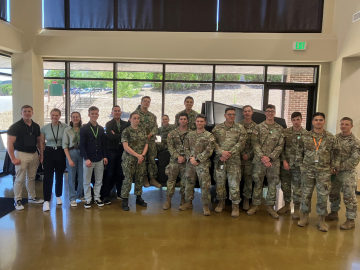
Filter News
Area of Research
- Advanced Manufacturing (1)
- Biology and Environment (5)
- Clean Energy (24)
- Electricity and Smart Grid (1)
- Fuel Cycle Science and Technology (1)
- Fusion and Fission (3)
- Isotopes (2)
- Materials (35)
- Materials for Computing (4)
- National Security (30)
- Neutron Science (9)
- Nuclear Science and Technology (3)
- Supercomputing (15)
News Type
News Topics
- (-) Critical Materials (6)
- (-) Grid (27)
- (-) Materials Science (56)
- (-) National Security (45)
- (-) Physics (35)
- (-) Security (12)
- 3-D Printing/Advanced Manufacturing (46)
- Advanced Reactors (9)
- Artificial Intelligence (49)
- Big Data (30)
- Bioenergy (52)
- Biology (61)
- Biomedical (30)
- Biotechnology (13)
- Buildings (25)
- Chemical Sciences (29)
- Clean Water (15)
- Climate Change (55)
- Composites (9)
- Computer Science (92)
- Coronavirus (18)
- Cybersecurity (14)
- Decarbonization (50)
- Education (1)
- Emergency (2)
- Energy Storage (36)
- Environment (111)
- Exascale Computing (27)
- Fossil Energy (4)
- Frontier (26)
- Fusion (33)
- High-Performance Computing (45)
- Hydropower (5)
- Isotopes (29)
- ITER (2)
- Machine Learning (23)
- Materials (45)
- Mathematics (7)
- Mercury (7)
- Microelectronics (3)
- Microscopy (23)
- Molten Salt (1)
- Nanotechnology (20)
- Net Zero (8)
- Neutron Science (52)
- Nuclear Energy (61)
- Partnerships (19)
- Polymers (11)
- Quantum Computing (21)
- Quantum Science (32)
- Renewable Energy (1)
- Simulation (32)
- Software (1)
- Space Exploration (12)
- Statistics (1)
- Summit (31)
- Sustainable Energy (50)
- Transformational Challenge Reactor (3)
- Transportation (32)
Media Contacts

A study found that beaches with manmade fortifications recover more slowly from hurricanes than natural beaches, losing more sand and vegetation. The researchers used satellite images and light detection and ranging data, or LIDAR, to measure elevation changes and vegetation coverage. Changes in elevation showed how much sand was depleted during the storm and how much sand returned throughout the following year.

At ORNL, a group of scientists used neutron scattering techniques to investigate a relatively new functional material called a Weyl semimetal. These Weyl fermions move very quickly in a material and can carry electrical charge at room temperature. Scientists think that Weyl semimetals, if used in future electronics, could allow electricity to flow more efficiently and enable more energy-efficient computers and other electronic devices.

Benjamin Manard, an analytical chemist in the Chemical Sciences Division of the Department of Energy’s Oak Ridge National Laboratory, will receive the 2024 Lester W. Strock Award from the Society of Applied Spectroscopy.

Ten future U.S. Army officers recently visited ORNL to learn about the legacy of nuclear science. As students of the Nuclear Science and Engineering Research Center, or NSERC, with the Defense Threat Reduction Agency, or DTRA, they stopped in East Tennessee as part of a larger tour across nuclear facilities supporting the military. In Oak Ridge, they visited ORNL to gain an appreciation of the history of the Manhattan Project and how research at a national lab contributes new materials and electronics for the nuclear industry.

Scientists have determined that a rare element found in some of the oldest solids in the solar system, such as meteorites, and previously thought to have been forged in supernova explosions, actually predate such cosmic events, challenging long-held theories about its origin.

The world’s fastest supercomputer helped researchers simulate synthesizing a material harder and tougher than a diamond — or any other substance on Earth. The study used Frontier to predict the likeliest strategy to synthesize such a material, thought to exist so far only within the interiors of giant exoplanets, or planets beyond our solar system.
Joe Tuccillo, a human geography research scientist, leads the UrbanPop project that uses census data to create synthetic populations. Using a Python software suite called Likeness on ORNL’s high-performance computers, Tuccillo’s team generates a population with individual ‘agents’ designed to represent people that interact with other agents, facilities and services in a simulated neighborhood.

Power companies and electric grid developers turn to simulation tools as they attempt to understand how modern equipment will be affected by rapidly unfolding events in a complex grid.

Researchers at the Department of Energy’s Oak Ridge National Laboratory and partner institutions have launched a project to develop an innovative suite of tools that will employ machine learning algorithms for more effective cybersecurity analysis of the U.S. power grid.

Brian Sanders is focused on impactful, multidisciplinary science at Oak Ridge National Laboratory, developing solutions for everything from improved imaging of plant-microbe interactions that influence ecosystem health to advancing new treatments for cancer and viral infections.


